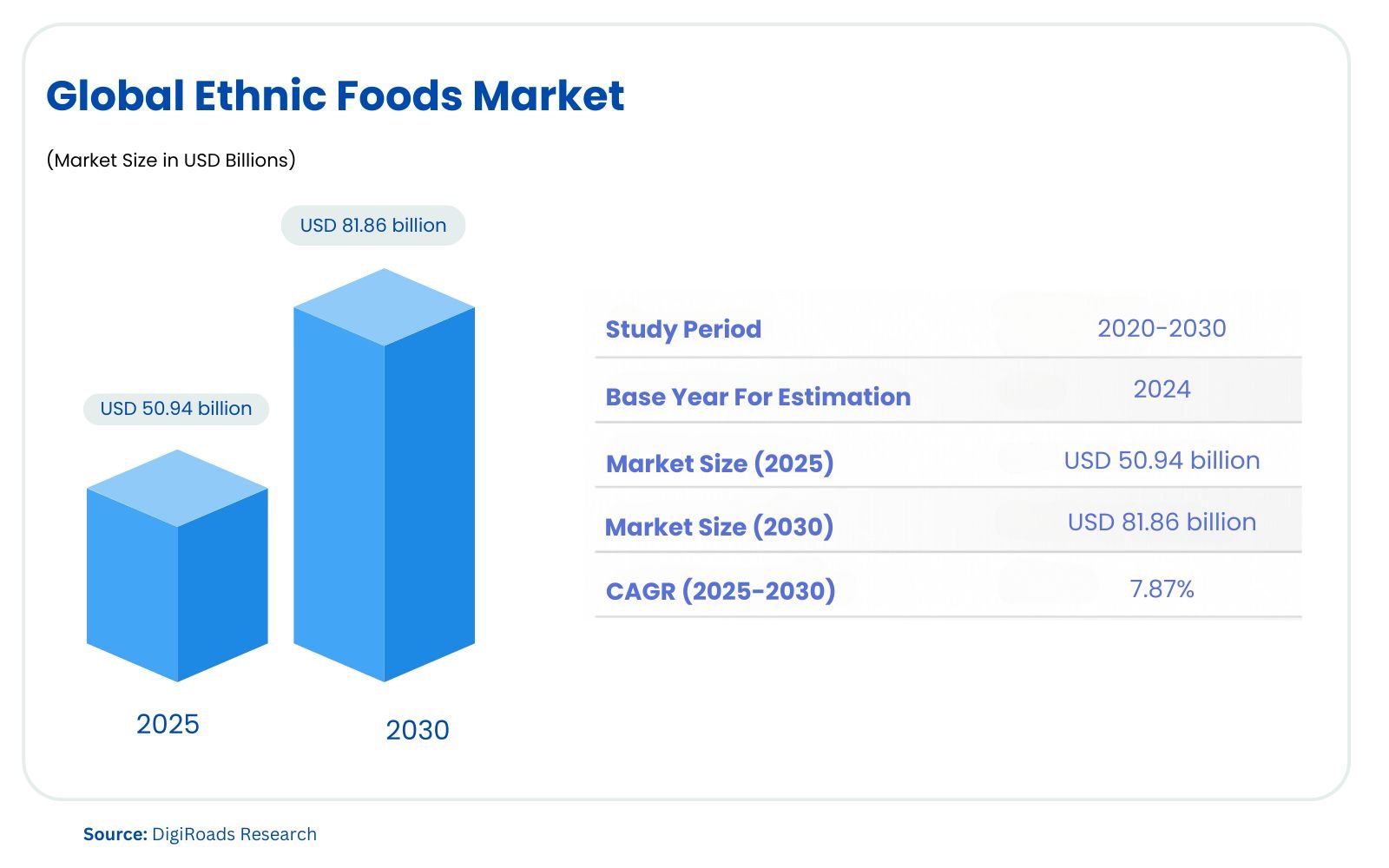Global Ethnic Foods Market
- Brand: DigiRoads
Global Food and Beverage Market Report on Ethnic Foods: This 100+ pages report offers detailed insights into market trends, cultural influences, and competitive landscape. Available in PDF and Excel formats for comprehensive analysis and easy data access.
Global Ethnic Foods Market Report | Market Size, Industry Analysis, Growth Opportunities, & Forecast (2025-2030)
Global Ethnic Foods Market Overview
The global Ethnic Foods Market is set for an exciting journey, starting at USD 50.94 billion in 2025, and is projected to reach USD 81.86 billion by 2030, expanding at a CAGR of 7.87% leading the way. This growth is driven by increasing consumer demand for diverse, authentic cuisines, fueled by globalization, migration, and the popularity of international food products. Asian cuisine leads the market, particularly Thai, Chinese, and Indian food, while Mexican and Italian foods are also growing in demand. The market is further boosted by the rise of frozen ethnic food products, technological advancements in preservation, and a shift toward online sales channels.
Regions such as North America, Europe, and the Asia Pacific are key players in the ethnic food industry. North America, in particular, is seeing a surge in demand due to the growing Asian and Hispanic populations. Additionally, consumer preferences are evolving, with a rising inclination toward vegetarian and plant-based food options. This report provides a comprehensive analysis of market trends, key players, regional dynamics, and factors shaping the future of ethnic cuisine across the globe.
Market Report Coverage:
The “Global Ethnic Foods Market Report—Future (2025-2030)” by Digiroads Research & Consulting covers an in-depth analysis of the following segments in the market.
| Cuisine Type | Asian, Italian, Mexican, Others |
| Food Type | Veg, Non-Veg |
| Distribution Channel | Hypermarkets/Supermarkets, Convenience Stores, Grocery Stores, Online Sales |
| Region | North America, Europe, Asia Pacific, South America, Middle East & Africa |
| Key Countries | U.S., Canada, Mexico, U.K., France, Italy, China, India, Brazil, Argentina, South Africa, Turkey |
Study Assumptions and Definitions
The study on the Global Ethnic Foods Market is based on several key assumptions and definitions to ensure accuracy and clarity in the market analysis. The report assumes that the market’s growth trends, challenges, and opportunities will follow the historical trajectory unless influenced by external factors such as geopolitical events, economic crises, or pandemics.
- Market Scope: The market encompasses ethnic foods originating from various global cuisines, including but not limited to Asian, Italian, Mexican, and other regional foods.
- Cuisine Type: Ethnic foods are categorized based on their geographical origin and cultural heritage, such as Asian (Indian, Chinese, Thai, etc.), Italian, Mexican, and others.
- Food Type: The market is segmented into vegetarian and non-vegetarian food products, catering to a wide range of consumer preferences.
- Distribution Channels: The report focuses on key distribution channels, including hypermarkets/supermarkets, convenience stores, grocery stores, and online sales platforms, reflecting consumer buying behavior.
- Regions: The study covers multiple regions, including North America, Europe, Asia Pacific, South America, and the Middle East & Africa, recognizing the varying market dynamics in each region.
Market Scope
The market scope of the Global Ethnic Foods Market encompasses a diverse range of food products originating from various global cuisines, including Asian, Italian, Mexican, and others. This market includes both vegetarian and non-vegetarian food types, catering to different consumer preferences. Ethnic foods are defined by their cultural and regional origins, with demand driven by factors such as migration, globalization, and changing consumer tastes.
The market scope also covers various distribution channels, including hypermarkets, supermarkets, grocery stores, convenience stores, and online sales platforms. The increasing popularity of online shopping for ethnic foods has expanded market access to a broader consumer base, making ethnic cuisines more accessible worldwide.
Geographically, the market spans across North America, Europe, Asia Pacific, South America, and the Middle East & Africa, with significant market shares in regions like Asia Pacific and North America, driven by high consumption and population migration. The scope of this market reflects the growing integration of ethnic foods into mainstream diets.
MARKET OUTLOOK
Executive Summary
The Global Ethnic Foods Market is witnessing significant growth, driven by the increasing demand for diverse and culturally rich food offerings across the world. The market’s growth is largely attributed to the growing global migration, consumer interest in exploring international flavors, and the availability of ethnic foods in various regions.
Asia Pacific dominates the ethnic food market, accounting for a significant share in 2024 due to the region’s extensive cultural diversity and large-scale production of ethnic foods. The U.S. and Europe also show steady demand for Asian, Italian, and Mexican cuisines, fueled by consumer preferences and increasing numbers of immigrants from these regions. The rise in consumer inclination toward frozen ethnic foods, such as ready-to-eat meals and frozen snacks, is further contributing to market expansion.
The market is segmented based on cuisine type (Asian, Italian, Mexican, and others), food type (vegetarian and non-vegetarian), and distribution channels (hypermarkets/supermarkets, grocery stores, convenience stores, and online platforms). Among these, the non-vegetarian food segment holds the largest share, while the vegetarian food segment is the fastest-growing due to the rising awareness of plant-based diets.
However, the market faces challenges due to the growing consumer preference for natural ingredients, which impacts the preservation of ethnic foods during transportation. Additionally, the COVID-19 pandemic has affected production and distribution, leading to delays and supply chain disruptions.
Overall, the ethnic foods market is expected to continue expanding, with innovation in product offerings and distribution channels, particularly through online sales platforms, driving future growth.
COMPETITIVE LANDSCAPE
The Global Ethnic Foods Market is moderately fragmented, with regional and multinational players competing fiercely for market share.
Key Market Players
- Ajinomoto Co. Inc. (Japan)
- Associated British Foods PLC (U.K.)
- McCormick & Company Inc. (U.S.)
- MTR Foods (India)
- Nestle S.A. (Switzerland)
- General Mills (U.S.)
- Conagra Brands Inc. (U.S.)
- Tasty Bite Edibles Pvt. Ltd. (India)
- Taco Bell (U.S.)
- B&G Foods (U.S.)
Market Share Analysis
The Global Ethnic Foods Market is experiencing substantial growth, with key regions like Asia Pacific, North America, and Europe holding significant market shares. In 2023, Asia Pacific led the market, accounting for a huge percentage of the total share. This dominance is attributed to the region’s extensive cultural diversity, high production capacity of ethnic foods, and strong export presence, especially in countries like China, India, and Japan. The growing adoption of Asian cuisines worldwide has bolstered the region’s market position.
North America is also a major contributor, with the U.S. being a key player due to the increasing demand for Asian cuisines, particularly Thai and Chinese food. The U.S. ethnic food market is expected to grow significantly, driven by the large number of Asian immigrants and the popularity of frozen ethnic foods. The market is projected to grow significantly, propelled by technological advancements in food preservation and a rise in demand for ready-to-eat meals.
Europe shows steady demand for Italian and Spanish cuisines, though growth is slower compared to other regions due to the dominance of local foods. South America and the Middle East & Africa are also witnessing stable growth, fueled by regional preferences for Mexican and Asian foods, respectively.
Overall, the ethnic food market is expanding as consumers increasingly seek new flavors, with distribution channels, particularly online platforms, contributing to broader market accessibility.
MARKET DYNAMICS
Market Drivers and Key Innovations
The Global Ethnic Foods Market is driven by several factors, including changing consumer preferences, increased migration, and the growing popularity of ethnic cuisines across the globe.
Key Drivers:
- Migration and Relocation: With over 272 million international migrants worldwide, many of whom are from Asia, the demand for ethnic food has surged in various regions, especially in North America and the Middle East. This has led to a rising preference for foods like Asian, Mexican, and Italian cuisines.
- Rising Demand for Convenience: Busy lifestyles and an increase in working populations have led to greater demand for ready-to-eat (RTE) and frozen ethnic foods. Consumers seek quick and easy meal solutions that don’t compromise on taste or authenticity.
- Globalization and Cross-Cultural Exchanges: As international travel and cultural exchanges increase, ethnic cuisines are becoming more mainstream, with traditional dishes gaining popularity across borders.
Market Challenges
- Cultural and Taste Preferences: Adapting ethnic food to local tastes while maintaining authenticity can be challenging. Some regions may resist non-local flavors, limiting the expansion potential of certain ethnic cuisines.
- Regulatory and Compliance Issues: Different countries have varying food safety and import regulations, which can complicate the distribution of ethnic foods. Compliance with local food labeling, health standards, and ingredient regulations can be time-consuming and costly.
- Supply Chain and Distribution Barriers: Global distribution of ethnic foods often involves long-distance transportation, which can be affected by delays, increased transportation costs, and spoilage risks. Maintaining product freshness and quality is a significant challenge, especially for perishable goods.
- Sourcing and Ingredient Availability: Authentic ethnic foods often rely on specific regional ingredients, which can be difficult to source in non-native markets. Limited access to traditional ingredients may lead to substitutions, affecting the taste and authenticity of the product.
- Consumer Education and Awareness: In some regions, consumers may not be familiar with ethnic cuisines, leading to hesitance in trying new products. Educational campaigns and marketing strategies are essential to build awareness and attract new customers.
- Price Sensitivity: Ethnic foods, especially premium or imported products, can be perceived as expensive in certain markets. This price sensitivity may limit the growth potential in price-conscious consumer segments.
- Competition from Local Foods: In many regions, local cuisines dominate consumer preferences, making it difficult for ethnic food products to compete, particularly in markets where ethnic foods are less established.
Market Opportunities
- Growing Popularity of Plant-Based and Vegan Foods: With increasing demand for plant-based diets, ethnic food brands can tap into this trend by offering more plant-based and vegan options, such as vegan tacos, plant-based curries, and Asian vegetarian dishes.
- Expansion of Online Sales Channels: The rise of e-commerce presents a significant opportunity for ethnic food brands to reach global consumers. Online platforms allow easy access to a variety of ethnic food products, especially for niche markets where ethnic foods are not widely available in local stores.
- New Product Innovations: There is potential for ethnic food manufacturers to innovate by introducing new products, flavors, and fusion cuisines. Combining ethnic flavors with popular local dishes can attract a wider audience and create new market segments.
- Rising Demand in Emerging Markets: As economies grow and urbanization increases in regions like Asia Pacific, Latin America, and the Middle East, the demand for diverse ethnic cuisines will rise. This opens up opportunities for ethnic food manufacturers to enter new and growing markets.
- Health-Conscious Consumers: The growing trend toward healthy eating provides an opportunity for ethnic food brands to offer healthier versions of traditional dishes. This could include gluten-free, low-calorie, or organic ethnic food options.
- Culinary Tourism and Travel: As travel and tourism continue to rise, more people are exposed to different ethnic cuisines. This exposure creates demand for authentic ethnic food products in international markets, particularly in regions with large numbers of tourists.
- Cultural Integration and Globalization: Increasing cultural exchange and global migration are opening doors for ethnic foods to be more widely accepted and integrated into the mainstream food market. Ethnic food products are becoming part of everyday meals in many countries, offering significant growth potential.
RECENT STRATEGIES & DEVELOPMENTS IN THE MARKET
- Product Diversification and New Product Launches:
-
- Haldiram’s Foods entered the premium chocolate market in January 2024 to compete with established players and strengthen its presence in the sweets & snacks sector.
- O’Food launched its first frozen food product, Mandu (Korean dumplings), in June 2022, offering two flavors: Kimchi and Plant-Based Mandu, to appeal to a wider consumer base.
- Geographic Expansion and Market Entry:
- Mizkan Group expanded its Japanese sauces and rice vinegar offerings in the U.S. market starting in February 2020. This move increased its footprint in North America.
- General Mills partnered with U.S. chip brand Takis in October 2021 to introduce new flavors of taco shells, expanding its Old El Paso product line and targeting North American consumers.
- Acquisitions to Enhance Market Reach:
- McCormick & Company acquired Cholula Food Company in November 2020 for USD 800 million. The acquisition aimed to expand McCormick’s portfolio in the hot sauce segment, enhancing its position in the ethnic food market.
- Technological Advancements in Food Preservation:
- Many players are focusing on improving preservation and freezing technologies. For instance, companies like O’Food have introduced frozen ethnic food products like Mandu, utilizing advanced freezing techniques to preserve taste and quality during transport.
- Adoption of Sustainable and Health-Conscious Offerings:
- Brands are launching more sustainable and health-conscious ethnic food products to cater to the growing demand for plant-based, organic, and non-GMO options. The trend toward natural ingredients and cleaner labeling is gaining momentum.
- Increased Focus on Online Sales Channels:
- As e-commerce grows, many ethnic food brands are strengthening their online presence to cater to global consumers. This is in line with the increasing demand for home delivery and the convenience of shopping for ethnic foods online. For example, Ajinomoto Co. has enhanced its online distribution channels to reach wider audiences.
KEY BENEFITS FOR STAKEHOLDERS
Increased Market Access:
- Stakeholders can expand their geographic reach through partnerships and market entry strategies, tapping into growing ethnic food demand across regions like North America, Europe, and Asia-Pacific.
Enhanced Revenue Opportunities:
- With the growing popularity of ethnic cuisines, stakeholders can leverage product diversification (e.g., frozen foods, plant-based options) and appeal to evolving consumer preferences, driving revenue growth.
Strategic Competitive Advantage:
- Companies that innovate and invest in health-conscious, sustainable, and culturally diverse offerings can establish a competitive edge in the market, meeting the needs of modern consumers who are increasingly prioritizing nutrition and sustainability.
Strong Consumer Demand:
- The increasing migration trends, globalization, and changing demographics are creating sustained demand for ethnic food products. Stakeholders benefit from these growing consumer bases in both established and emerging markets.
Growth in Online Sales Channels:
- The rise of e-commerce platforms and online grocery stores offers stakeholders the opportunity to expand their distribution channels, making ethnic food products more accessible to global consumers, thereby enhancing visibility and sales.
Technological Advancements:
- By investing in advanced food preservation and freezing technologies, stakeholders can improve product shelf life, ensure quality during transport, and reduce waste, enhancing operational efficiency and consumer satisfaction.
Cultural and Product Diversification:
- Stakeholders have the opportunity to cater to diverse tastes and preferences, offering an array of ethnic food products that can appeal to various cultural groups. This diversification helps capture larger market segments and increase brand loyalty.
Sustainability and Brand Image:
- Companies focusing on clean labeling, natural ingredients, and environmentally sustainable practices can strengthen their brand image and align with consumer values, particularly in markets that prioritize health and sustainability.
At DigiRoads Research, we emphasize reliability by employing robust market estimation and data validation methodologies. Our insights are further enhanced by our proprietary data forecasting model, which projects market growth trends up to 2030. This forward-thinking approach ensures our analysis not only captures the current market landscape but also anticipates future developments, equipping stakeholders with actionable foresight.
We go a step further by offering an exhaustive set of regional and country-level data points, supplemented by over 60 detailed charts at no additional cost. This commitment to transparency and accessibility allows stakeholders to gain a deep understanding of the industry’s structural and operational dynamics. By providing exclusive and hard-to-access data, DigiRoads Research empowers businesses to make informed strategic decisions with confidence.
In essence, our methodology and data delivery foster a collaborative and data-driven decision-making environment, enabling businesses to navigate industry challenges and capitalize on opportunities effectively.
Contact Us For More Inquiry.
Table of Contents
-
INTRODUCTION
- Market Overview
- Years Considered for Study
- Market Segmentation
- Study Assumptions and Definitions
- Market Scope
-
RESEARCH METHODOLOGY
-
MARKET OUTLOOK
- Executive Summary
- Market Snapshot
- Market Segments
- Cuisine Type:
- Asian, Italian, Mexican, Others
- Food Type:
- Veg, Non-Veg
- Distribution Channel:
- Hypermarkets/Supermarkets, Convenience Stores, Grocery Stores, Online Sale
- Cuisine Type:
-
COMPETITIVE LANDSCAPE
- Recent Strategies (Key Strategic Moves)
- Market Share Analysis
- Company Profiles
- Ajinomoto Co. Inc. (Japan)
- Associated British Foods PLC (U.K.)
- McCormick & Company Inc. (U.S.)
- MTR Foods (India)
- Nestle S.A. (Switzerland)
- General Mills (U.S.)
- Conagra Brands Inc. (U.S.)
- Tasty Bite Edibles Pvt. Ltd. (India)
- Taco Bell (U.S.)
- B&G Foods (U.S.)
-
MARKET DYNAMICS
- Market Drivers
- Market Challenges
- Market Opportunities
- Porter’s Five Forces’ Analysis
- Bargaining Power of Suppliers
- Bargaining Power of Buyers
- Threat of New Entrant
- Threat of Substitutes
- Competitive Rivalry
-
GLOSSARY OF PROMINENT SECONDARY SOURCES
-
DISCLAIMER
-
ABOUT US



